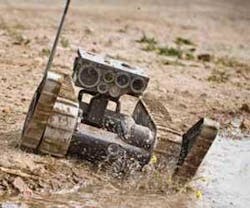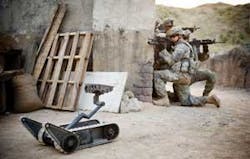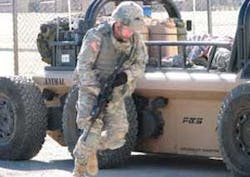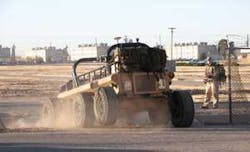Unmanned ground vehicle (UGV) technology has been in development for decades, but the Army’s Future Combat Systems program and the need to keep military personnel out of harm’s way are building momentum like never before to begin manufacturing and deploying UGVs in large numbers.
By John Keller
Military robots for ground applications are coming into their own as U.S. Department of Defense (DOD) leaders are increasing their reliance on unmanned ground vehicles (UGVs) for tasks that are boring, dirty, or dangerous so as to free up soldiers for specialized tasks where only human intelligence will suffice.
Until very recently, robots for military ground applications have primarily been limited to explosive ordnance disposal (EOD), where a military robot uses its suite of sensors to locate and destroy roadside bombs called improvised explosive devices (IEDs), the likes of which have killed or injured hundreds of soldiers and civilians in Iraq and Afghanistan.
Today, however, military leaders are getting ready to deploy the military robot for a wide variety of future applications for unmanned vehicles on the ground, including UGV reconnaissance, surveillance, and target acquisition (RSTA); logistics and cargo transportation; security and engineering, such as obstacle breaching; medical applications like removing wounded from the battlefield; maintenance of vehicles and machinery; target acquisition and designation; route clearance; mine and IED detection and disposal; and eventually perhaps in armed robotic applications in which killer robots provide fire support on the battlefield and enhance the punch of an infantry assault.
While military robotic applications even recently were considered to be the futuristic stuff of science fiction, Army robotics is here now, and it’s here to stay. Small UGVs like the iRobot Packbot are in use today in Iraq and Afghanistan detecting and destroying IEDs, while major programs like the Army’s Future Combat Systems (FCS) are expected to field UGV systems in substantial numbers within the next few years.
“We are at a transition point between where the market has been and where the market is going,” explains retired Navy Vice Adm. Joseph Dyer, president of the iRobot Corp. government and industrial division, a designer of small unmanned ground vehicles (SUGVs) in Bedford, Mass.
“Robots really found their first niche with the IED threat in Iraq and Afghanistan, but an important transition point happened in 2009, where robots are finding their way into being a tool for the infantry, or the Big Army,” Dyer says. “It is a much larger role for robots to be a tool and a partner for the military. While EOD is important to the soldier and to a budding robot industry, the Big Army is a much bigger market, and a much larger opportunity for robots to serve.”
Different sizes of UGVs
With such a broad variation in anticipated military robotics applications, the ground robot will come in several different sizes and configurations. For today’s purposes, Army robots typically come in a simple array: small, medium, and large. Within that framework, the separate unmanned vehicle applications will come from the ground robotics payloads assigned to each UGV, such as sensors, manipulators, propulsion, and fuel, as well as cargo space and even battery recharging ports.
The multispectral sensor payload of the iRobot SUGV system will give this small robot a big surveillance and reconnaissance capability.
The small UGVs range between about 30 and 100 pounds, and are sized so that soldiers can hand-carry them to where they need to be. They generally run on battery power, so electrical power management is a pressing design issue. These small bots must be able to propel themselves to their action areas and operate their payloads, and recharge without running out of juice. These unmanned systems also must operate in areas where the terrain is not overly challenging–although they are designed to climb over or go around many kinds of battlefield obstacles.
In addition to EOD missions, the small UGVs can perform reconnaissance and surveillance, can inspect vehicles for hidden explosives, act as medic assistants on the battlefield, and other tasks where their size and weight is not a disadvantage, and where they are not asked to lift heavy loads.
Examples of small UGVs are the iRobot Packbot, which weighs about 60 pounds, and the Small Unmanned Ground Vehicle, also called the SUGV, which weighs 30 pounds. The iRobot SUGV is to be a cornerstone of the Army FCS program’s unmanned ground vehicle initiative.
The medium-sized UGVs range between about 300 and 1,000 pounds, and must be transported to their operating areas by truck, aircraft, or on their own; they are too heavy for people to lift. It is their size, weight, and affordability that represent their biggest advantages, because they can lift and carry relatively heavy loads and operate in rugged terrain.
The medium-size UGVs also can be an affordable option for users who need to move substantial loads, but cannot afford the larger kinds of UGVs. One medium-size UGV is the unmanned crossover land vehicle from Black-I Robotics in Tyngsboro, Mass.
The MULE UGV is designed to help infantry soldiers by carrying equipment, food, water, fuel, and ammunition into battle.
The large UGVs are the sizes of trucks, and are designed to lift, carry, or tow heavy loads. Their diesel and hybrid electric propulsion systems also enable them to operate in the field for long periods, and to act as battery charging stations or even as mother ships to carry small UGVs into and out of operating areas, as well as charging the small UGV batteries while in the field.
Among the best examples of large UGVs are the multifunction utility logistics equipment (MULE) UGV from the Lockheed Martin Corp. Combat Maneuver Systems segment in Grand Prairie, Texas, as well as the experimental tracked Black Knight from the BAE Systems Ground Systems segment in Santa Clara, Calif.
UGV enabling technologies
In addition to performing various specific tasks that might require some level of expertise, UGVs often must operate unattended for certain periods of time. It is somewhat of an electronics architectural challenge to blend the right kinds of enabling technologies in UGVs while still keeping these unmanned systems functional and affordable.
Among the most important enabling technologies for UGVs are sensors that enable the vehicle to perceive its environment and make rudimentary decisions on whether to go over or around obstacles, and to find its way back to a pre-programmed string of way points after it deviates from its intended path to avoid obstacles.
The most common sensor suite for UGVs involves some combination of lidar, video camera, infrared camera, and collision-avoidance radar. Lidar is short for light direction and ranging, and often is called ladar, or laser radar.
“We need a robust enough sensor suite to perceive the environment and operate safely around people and moving obstacles like other vehicles,” explains Chris Mocnik, a UGV and robotics expert at the U.S. Army Tank-Automotive Research, Development, and Engineering Center (TARDEC) in Warren, Mich. We have to have the resolution to see these obstacles, and then have the processing intelligence to determine, based on sensor feedback, what is or is not an obstacle of concern, an obstacle I need to go around, or an obstacle I need to go over. Then we need the intelligence to path-plan based on that information.”
The lidar sensor enables the UGV to create a 3D picture of the environment around the vehicle, so it can judge the severity of obstacles, objects to avoid, things or people of interest, and to travel safely along a pre-determined path. “We can use ladar to paint a relatively high-resolution map of the terrain surrounding the vehicle,” Mocnik says. “Video cameras, radars, and ladars are the sensors we use most often.”
Sensor processing
Sensor processing and sensor fusion also are chief UGV enablers to make sense of what the vehicle’s sensor suite perceives. “The biggest challenge we have been dealing with in unmanned ground vehicles is the vision systems and how to add cognitive capabilities,” says Mike Macpherson, director of business development for embedded computing at the Curtiss-Wright Embedded Controls segment in Leesburg, Va.
“We provide general processing capability for vehicle management,” Macpherson says. “We look at the sensor systems and the ability to process that information. We use our family of multicomputing systems, which are well suited for that. VPX 3U embedded computing lends itself very well for this market space. Our embedded computing is ruggedized, and blends price and performance for that requirement.”
One might think the sensor processing needs of an unmanned ground vehicle might be relatively simple compared to those of unmanned aerial vehicles (UAVs), but quite the opposite is true, experts point out. UAVs–and unmanned underwater vehicles (UUVs)–often can simply traverse clear, unobstructed air or water while performing their missions. For UGVs moving along uneven ground, however, often every moment and every foot require decisions based on sensor processing to compensate for dips and rises, holes, puddles, cracks in pavement, and countless other conditions that challenge a UGV and its subsystems.
“We do the sensor fusion to blend ladar with electro-optical systems to create a 3D view with collision avoidance,” Macpherson says. Simple things like discerning a rock from a bush creates processing requirements that are greater than we can imagine, and greater than those of UAVs.”
Machine autonomy
Unmanned ground vehicle designers can get a little touchy when the subject of machine autonomy comes up. They get tired of explaining that ground robot autonomy in today’s military does not mean the kind of artificial intelligence and android beings that people see in the movies.
One of the best descriptions of machine autonomy is “supervised autonomy,” which essentially means that UGVs are programmed within tight limits of what they can do, where they can go, and how they can get there. If a military ground robot encounters an obstacle it can’t go over or around, or has no alternative than to traverse ground from which it is restricted, these vehicles are programmed to stop and ask for help from human operators.
To get UGVs the help they need, human operators often step in and go into teleoperated mode where a human has control. When the problem is solved, then the UGV can go back to supervised autonomous mode and operate within its limited parameters–at least until the next time it encounters a bad situation and needs to ask for help. If a stuck UGV cannot contact a human operator, it often is programmed to retrace its path back to where it last had contact with human operators. If that doesn’t work, then the UGVs can be pre-programmed to return back to their bases of operations. This capability reduces the need for humans to go into the field to retrieve UGVs that are confused and don’t know the next thing to do.
The Lockheed Martin multifunction utility logistics equipment UGV–better known as the MULE–weighs 7,000 pounds and can serve infantry soldiers as an unmanned cargo truck.
Another rudimentary autonomous task receiving substantial interest in the UGV community is “follow-me” capability. This involves an RF device attached to a person, a manned vehicle, or another UGV that an unmanned ground vehicle can sense and follow at a pre-programmed distance. A soldier, for example, could have such an RF device in his back pocket, and a UGV will follow him five or 10 feet behind. Similarly, these “follow-me” devices could be fitted to several UGVs to enable them to form a convoy behind a manned or teleoperated vehicle.
“Machine autonomy today is not a big bang,” explains iRobot’s Dyer. “Supervised autonomy is where the robot says, ‘I could use a little help here.’ The human takes on more of a supervisory role than an operator role. It will be the late 2030s at the earliest before you have a robot that you could take out for a beer, and it will be a long time from today before we have an android assistant.”
Machine autonomy for UGVs is a crucial need, however, and not only to reduce the workload on human operators. The preferred method of working UGVs is teleoperation, where a human operator transmits commands and views sensor information over an RF datalink.
“In general, most of the control commands are pretty easily handled, but if you are looking at visual data coming back from your robot, it takes up a lot of bandwidth,” says Tom Mohler, program manager for advanced programs at BAE Systems. “How do you get enough information to and from the platform for it to be really effective,” Mohler asks. “Right now most all the demonstration systems essentially use digital wireless communications. I don’t know if there is much of an alternative.”
Communications bandwidth
The bandwidth of those RF links are limited, and demands on them are great for handling streaming video, surveillance information, inter-vehicular information, status reports, and many other tasks.
“One of our biggest and most problematic areas is data communications on the battlefield,” says TARDEC’s Mocnik. “We are starting to run into problems having enough bandwidth to pass all that data around that you need to, and having the communications in place for adequate control and feedback–particularly for teleoperation where the operator has to drive using the vehicle’s video.”
Increasing the number of tasks that a UGV can perform autonomously without using RF links might be a big enabler in dealing with the bandwidth problem. “In autonomy, depending on how you set up your applications, you can rely on the robot to sense and perceive its environment, so you free up that little bit of bandwidth,” Mocnik says. “Teleoperation may actually be a bit of a stresser on the communications backbone.”
Providing the electrical power necessary for UGV propulsion, as well as for operating the unmanned vehicle’s on-board systems continues to be a major issue–particularly for the small UGVs that run exclusively on battery power.
“Robots have high peak power demands, in addition to their power loads of just staying awake and looking about,” says iRobot’s Dyer. “Steep and rough terrain has very high power demands.” For now, UGVs will take advantage of the cutting edge of battery technologies, and investigate future advances in fuel cells and hybrid electric power, he says.
Mid-size UGVs use a combination of batteries linked to onboard conventional diesel or gasoline generators to provide adequate power and time in the field, says Bob Hughes, vice president of marketing and sales at Black-I Robotics. The company’s unmanned crossover land vehicle, which weighs 400 to 450 pounds, has an on-board generator to charge its batteries on the move.
The Lockheed Martin MULE large UGV, meanwhile, now uses a diesel electric propulsion system, which similar to large railroad locomotives uses diesel engines to run high-power generators, which provide electric power to drive the wheels. This vehicle weighs 7,000 pounds, and potentially could act as a movable battery recharging station in the field, or as a mother ship to several small UGVs.
“Later, when they build hybrid electric systems that are lighter and more affordable than they are today, we will integrate that technology and make the MULE a hybrid electric system,” says Don Nimblett, manager of business development at Lockheed Martin Combat Maneuver Systems.
Current UGV offerings
Among the most high-profile UGV offerings today is the iRobot Small Unmanned Ground Vehicle (SUGV), which weighs 30 pounds, can be carried on a soldier’s back, and has day and night multispectral sensor capability. The SUGV has a laser range finder, laser target designational capability, can take video and still photos, and pass intelligence and reconnaissance data over the tactical Internet.
The SUGV also has an optional teleoperated robotic arm that can pick up light objects, drag some heavier objects, and act as a soldier’s third hand when he needs help. Like its larger Packbot cousin, the track-driven SUGV has the distinctive flippers that help it balance and climb over obstacles.
The SUGV will fulfill the small unmanned ground vehicle requirement of the Army’s Future Combat Systems program. Dyer says iRobot has delivered 20 SUGV robots to Army experts at Fort Bliss, Texas, for accelerated test and integration with the FCS program. With future international sales considered, Dyer says he anticipates a total global market for small UGVs at 10,000 to 20,000. “That’s a bunch of robots,” he says.
In the mid-size category is the Black-I Robotics 400-pound unmanned crossover land vehicle. This vehicle is far lighter and less expensive than the Lockheed Martin MULE UGV, but has the heft to lift relatively large loads and with its on-board generator can operate in the field for as long as eight hours at a stretch.
The vehicle can easily carry hundreds of pounds, and is designed for carrying the gear of platoon-sized units. The vehicle also could carry extra food, water, and ammunition for light infantry forces, or with a sensor payload could perform perimeter security at military installations or other sensitive areas for eight-hour shifts between refueling and recharging.
One primary application of the unmanned crossover land vehicle is destruction of vehicle-borne IEDs with an optional robotic arm with six-foot extension that can lift loads as heavy as 100 pounds. This application calls for the vehicle to insert counter IED charges to mitigate the explosive force of the car-borne IED.
In the large UGV department, BAE Systems has developed the tracked Black Knight UGV, which essentially is a half-sized unmanned Bradley Fighting Vehicle. Although BAE Systems is not under contract to produce the Black Knight or any variant, company engineers are using the vehicle as a demonstrator of different large UGV capabilities.
One of the most notable demonstrations of Black Knight was in 2007 at an Army exercise at Fort Benning, Ga. “We brought our platform to that exercise to try out some ideas,” Mohler says. “We found it has value in having an unmanned reconnaissance point, such as waiting at an intersection and waiting for people to come.”
Perhaps the best known large UGV is the Lockheed Martin MULE, which will fulfill the large UGV requirement of the FCS program. The MULE, which is the size of a large truck, has three variants–a transport variant that can haul cargo or people, a counter-mine variant designed to clear and mark lanes through mine fields, and an armed variant should the Army decide on that requirement in the future.
“The transport variant is designed to carry the gear and supplies for two combat infantry squads, and support them for a 24-to-72-hour mission,” says Lockheed Martin’s Nimblett.” It can carry heavy rucksacks, sleeping bags, extra water, food, ammunition, assault ladders, and heavy weapons. It’s the soldier’s pickup truck.”
The counter-mine variant of MULE has a payload to detect and explode land mines that it detects, and can mark lanes that it clears with a system of flags that it plants in the ground behind it. The vehicle has a common chassis with six tires on shoulder-arm joints for maneuverability, each joint with an independent in-hub electric motor.
“Those shoulder joints can rotate around themselves about 230 degrees, which allows the vehicle to decompress and lower itself flat on the ground. It can roll to the right or left, and take a climbing pose,” Nimblett says. “It has the unique ability to climb over things. We have climbed a one-meter step and crossed a 1.8-meter gap.”
Building the autonomous navigation system for MULE is General Dynamics Robotic Systems in Westminster, Md.
On its own research-and-development budget, Lockheed Martin is developing a smaller version of MULE called the squad mission support system (SMSS), which is intended for light infantry forces. “There are a lot of Army and Marine Corps units out there that walk,” Nimblett explains. “MULE is too big to support those light forces. SMSS is generally about half the size of the MULE, will carry one squad worth of gear, and is designed to be sling-loaded underneath a UH-60 helicopter.”
Army officials are not ready to approve an armed UGV for battlefield use, but companies are betting that requirement will come eventually. “Arming an unmanned system is a very sticky topic,” admits TARDEC’s Mocnik. “Do you have a robot fire autonomously, or have a human in the loop? In the near term, I don’t see any autonomous firing of a weapon; any firing would be done in teleoperated mode.”
Although the Army has cancelled the Armed Robotic Vehicle (ARV) component of the FCS program, Lockheed Martin is developing an armed version of MULE called the Armed Robotic Vehicle-Light with an M240 7.62 millimeter machine gun and Javelin anti-tank missile launchers. Later versions could carry heavier weapons like a 50-caliber machine gun or 20 millimeter cannon, if that requirement arises.
“The armed variant is to provide heavy fire power to infantry units when they are dismounted from their vehicles,” Nimblett says. “It will be fairly heavily armored.”
Dyer at iRobot says he believes armed UGVs will come eventually. “Many military systems have evolved from reconnaissance to strike,” he says, speculating that non-lethal weapons like Taser guns may be deployed on UGVs as a stepping stone to fully armed systems.





